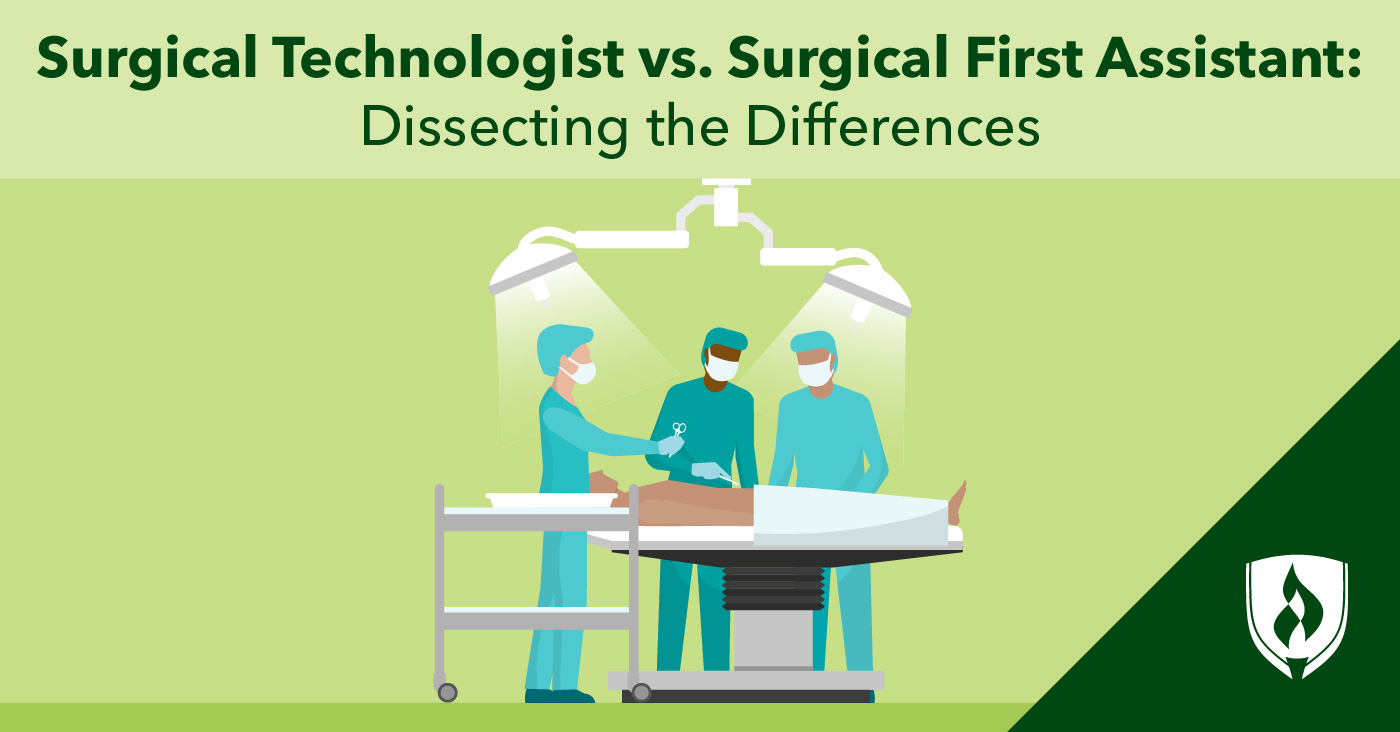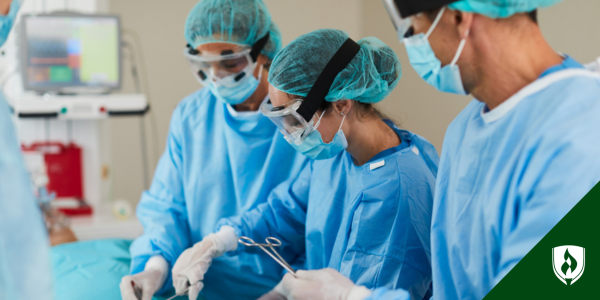Surgical Technologist vs. Surgical First Assistant: Dissecting the Differences
By Kirsten Slyter on 03/28/2022

You can see yourself in those distinct ceil blue operating room (OR) scrubs, at work early, preparing for the day’s lineup of patient surgeries. Taking on a hands-on role within the operating room sounds like an exciting and fascinating way to earn a living, but you’re also pretty sure that 10+ years of education and training needed to be a surgeon isn’t in your future.
So where can you turn if you’d like to get started in the OR sooner? While there are many operating room jobs to consider, you want an up-close view of the action. Both surgical technologists and surgical first assistants are right in the thick of things during an operation, but some of the distinctions between the two roles can get a little confusing. We’ll help with that—let’s walk through some of the key differences between these sometimes overlapping OR roles.
Surgical technologist vs. surgical first assistant: Job duties
You’ve probably figured out that both surgical technologists and surgical first assistants are involved with surgeries, but what do they actually do in their day-to-day work?
What does a surgical technologist do?
A surgical technologist’s main duties are to prepare and maintain a sterile environment for surgeries, provide the surgeon with necessary tools during the operation and assist the surgeon in performing surgical procedures. Surgical technologists often have the first interactions with patients and set the tone for surgery.
Here are a few other common surgical technologist duties, according to the Bureau of Labor Statistics (BLS):1
- Prepare patients for surgery
- Transport patients to operating and recovery rooms
- Support surgeons and nurses by providing tools and suturing wounds
- Observe and report patients’ vital signs
- Organize documentation of surgical procedures
- Utilize medical tools, such as internal staplers, surgical saws and drills
- Study patients’ medical histories
To learn more about the day-to-day of a surgical technologist, our article “Surgical Technologist Duties: A Day in the Life” can help shine a light on what to expect in the daily routine.
What does a surgical first assistant (SFA) do?
Like surgical technologists, surgical first assistants play a complementary role to the lead surgeon. The line for who handles what between surgical technologists and SFAs can blur depending on the structure of the OR team or the procedure being performed, but SFAs typically have an expanded range of duties during a procedure.
Generally, the surgical technologist deals more with the surgical instruments and preparation of the room, while the surgical first assistant is more focused on directly assisting the surgeon during the procedure by helping with manipulating patient tissue, placing catheters, suctioning, suturing and potentially even “harvesting” veins for bypass procedures. That said, the scope of a surgical first assistant’s duties will depend on state regulations and the educational background they possess, as there are several pathways to working in this role.
As you might expect, having an extra set of skilled and trusted hands available during complicated procedures can be a big help. Additional examples of potential first assistant duties include:
- Communicating with rest of the surgical team about the surgeon’s needs
- Suturing to close the incision at the end of the procedure
- Providing postoperative care like applying dressings to surgical wounds, assisting with patient transfer and monitoring for immediate-term complications
Surgical technologist vs. surgical first assistant: Education and training needed
While the educational path to becoming a surgical technologist is relatively straightforward, the education and training path to becoming a surgical first assistant can get a little complex, as there are multiple routes you can take to serving in this role.
How to become a surgical technologist
Surgical technologists typically need either a postsecondary nondegree award or an Associate’s degree, according to the BLS.1 In a Surgical Technologist program, you can expect to learn how to prepare an operating room for surgery, master aseptic techniques for maintaining a sterile environment, develop compassionate patient care skills and build a thorough understanding of surgical procedures through coursework, hands-on labs and practicum experiences.
While that might seem like a lot to take in, the time commitment can be manageable—the Rasmussen University Surgical Technologist Associate’s degree program can be completed in as few as 21 months.2
Surgical first assistant pathways
Here’s where things can get a little complicated. The surgical first assistant role can be held by several different types of healthcare professionals with varying educational backgrounds. Common first assistant options include:
- Physicians or resident physicians
- Advanced practice registered nurses (APRN)
- Physician assistants (PA)
- Registered nurses (with additional surgical assistant training)
- Surgical technologists (with additional surgical assistant training)
The details and education requirements for each of these pathways will vary, but there is one constant—all require a more substantial investment in education and training than a standard surgical technologist role.
Prospective surgical first assistants may also choose to pursue specialized training through Commission on Accreditation of Allied Health Education Programs (CAAHEP)-accredited programs for surgical assisting. These programs can range from 12 to 24 months and prepare students to sit for national certification examinations through the National Board of Surgical Technology and Surgical Assisting® (NBSTSA) or the National Commission for the Certification of Surgical Assistants (NCCSA).
Keep in mind that there are currently only a small number of CAAHEP-accredited surgical assisting programs in the U.S., so competition for admission may be strong. While requirements will vary by program, many will require:
- Either an Associate’s degree in a related allied health field or a Bachelor’s degree in a health-related science
- Specific coursework in human anatomy, basic sciences or microbiology
After you complete the program, you’ll become officially certified by sitting for—and passing—an exam administered through either the NBSTSA or the NCCSA. Once certified, surgical assistants work under the credentials of Certified Surgical First Assistant® (CSFA) or Certified Surgical Assistant (CSA).
Where do surgical technologists and surgical first assistants work?
You can find surgical technologists and surgical first assistants in nearly any setting where surgical procedures take place. According to the BLS, 73 percent of surgical technologists work in a hospital setting, 10 percent work in outpatient care centers and another 10 percent in physicians’ offices.1
Both surgical technologists and first assistants can find work in specific surgical focus areas like cardiology, labor and delivery, orthopedics and more.
Are you ready to step into the OR?
Surgical first assistants and surgical technologists both provide critical support for the surgeons who are making often life-or-death moves with their deft hands. Working in a surgical setting can be a fascinating, intense and exciting way to earn a living—and you can get the ball rolling on making that happen sooner than you might think.
To learn more about the path to becoming a surgical technologist, check out our article “How to Become a Surgical Technologist: The Step-by-Step Guide” for a straightforward breakdown of what’s to come. Also check out "Scrub Nurse vs. Surgical Tech: Decoding the Differences in the OR and Beyond", to explore all options.
1 Bureau of Labor Statistics, U.S. Department of Labor, Occupational Outlook Handbook, [February 2022] www.bls.gov/ooh/. Information represents national, averaged data for the occupations listed and includes workers at all levels of education and experience. Employment conditions in your area may vary.
2Completion time is dependent on the number of transfer credits accepted and the number of courses completed each term.
National Board of Surgical Technology and Surgical Assisting and Certified Surgical First Assistant are registered trademarks of the National Board of Surgical Technology and Surgical Assisting




